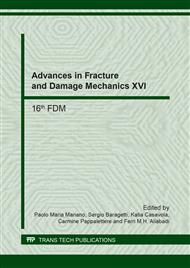p.210
p.214
p.218
p.222
p.226
p.230
p.237
p.241
p.244
On the Scale-Transition in Multiscale Modeling of Ductile Damage
Abstract:
The standard numerical methods cannot adequately capture damage response of ductile heterogeneous materials, since they are unable to encompass the governing microstructural mechanisms. This issue is resolved by the multiscale approach, where the coarse scale problem incorporates behavior at the lower scales. In this paper, a multiscale scheme is employed for scaling of ductile damage occurring at the microstructural level to the macrolevel. A nonlocal implicit damage model is applied on the RVE, while a scale transition is performed by means of the first-order homogenization scheme. The influence of the boundary conditions used at the microscale on the macroscale response, as well as physical consistency of the RVE mechanical behavior are tested. It has been shown that displacement boundary conditions inhibit development of the softening band inside of the RVE and induce artificial material stiffness. The derived algorithms are embedded into the finite element software ABAQUS.
Info:
Periodical:
Pages:
226-229
Citation:
Online since:
September 2017
Authors:
Price:
Сopyright:
© 2017 Trans Tech Publications Ltd. All Rights Reserved
Share:
Citation:


